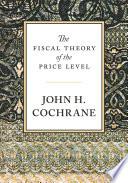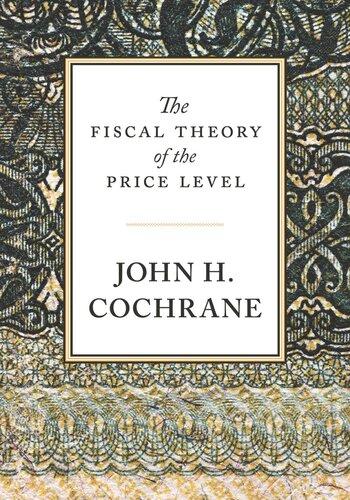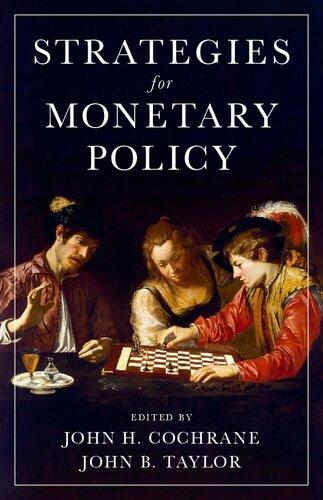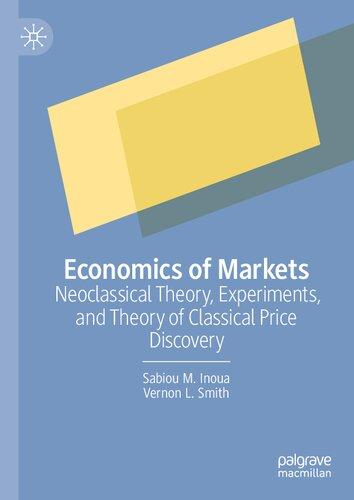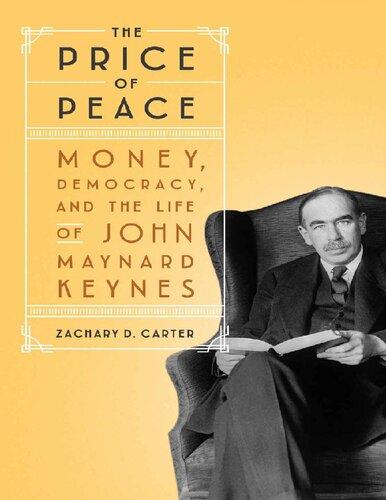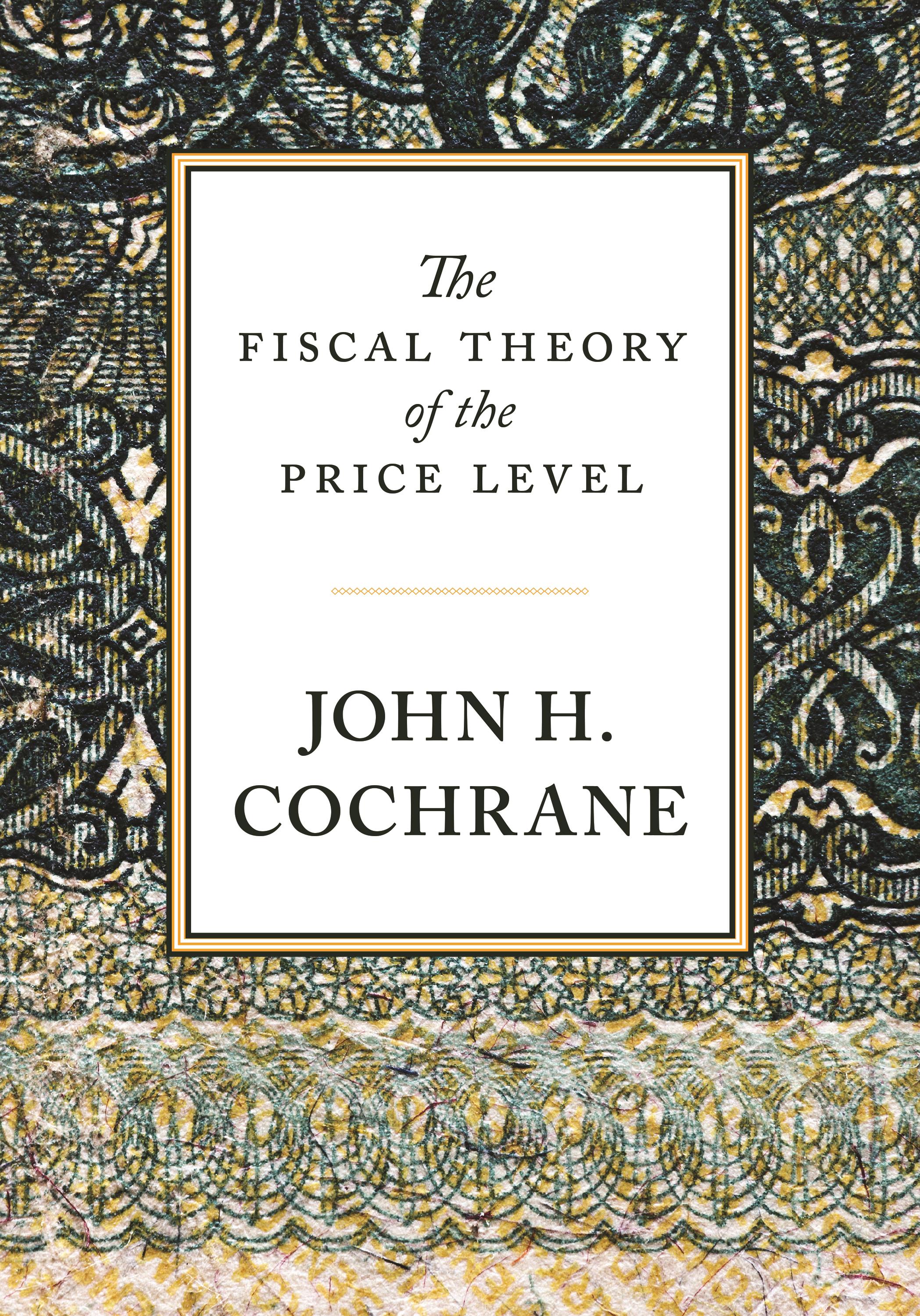TheFiscalTheoryofthe
Copyright c 2023byPrincetonUniversityPress
PrincetonUniversityPressiscommittedtotheprotectionofcopyrightandtheintellectualpropertyourauthors entrusttous.Copyrightpromotestheprogressandintegrityofknowledge.Thankyouforsupportingfreespeech andtheglobalexchangeofideasbypurchasinganauthorizededitionofthisbook.Ifyouwishtoreproduceor distributeanypartofitinanyform,pleaseobtainpermission.
Requestsforpermissiontoreproducematerialfromthiswork shouldbesenttopermissions@press.princeton.edu
PublishedbyPrincetonUniversityPress 41WilliamStreet,Princeton,NewJersey08540 99BanburyRoad,OxfordOX26JX
press.princeton.edu
AllRightsReserved
LibraryofCongressCataloging-in-PublicationData
Names:Cochrane,JohnH.(JohnHowland),1957–author.
Title:Thefiscaltheoryofthepricelevel/JohnH.Cochrane,Hoover Institution,StanfordUniversity.
Description:Princeton:PrincetonUniversityPress,[2023]|Includes bibliographicalreferencesandindex.
Identifiers:LCCN2022006785(print)|LCCN2022006786(ebook)| ISBN9780691242248(hardback)|ISBN9780691243245(epub)
Subjects:LCSH:Inflation(Finance)|Monetarypolicy.|Prices.
Classification:LCCHG229.C5532023(print)|LCCHG229(ebook)| DDC339.5/3—dc23/eng/20220214
LCrecordavailableathttps://lccn.loc.gov/2022006785
LCebookrecordavailableathttps://lccn.loc.gov/2022006786
BritishLibraryCataloging-in-PublicationDataisavailable
Editorial:JoeJackson,JoshDrake
JacketDesign:HeatherHansen
Production:ErinSuydam
Publicity:KateHensley,CharlotteCoyne
Copyeditor:AlisonS.Britton
JacketCredit: c Godlikeart/Shutterstock
ThisbookhasbeencomposedinArnoPro.
Printedonacid-freepaper. ∞
PrintedintheUnitedStatesofAmerica 10987654321
ToEricW.CochraneandLydiaG.Cochrane. Theirmemoryandexamplearewithmealways.
Aprince,whoshouldenactthatacertainproportionofhistaxesbepaidinapapermoney ofacertainkind,mighttherebygiveacertainvaluetothispapermoney.
—adamsmith, wealthofnations,vol.i,bookii,chapterii.
Thisbookisamidpoint,Ihope,ofalongintellectualjourney.Itstartedinthefallof1980, drinkingabeerandeatingnachosonasunlitafternooninBerkeley,withmygoodfriends andgraduateschoolstudygrouppartners,JimStock,EricFisher,DeborahHaas-Wilson, andSteveJones.Wehadbeenstudyingmonetaryeconomics,andthinkingaboutwhat happensaselectronictransactionsreducethedemandformoney.Whenmoneydemand andmoneysupplyconvergeonfast-movingelectronicclaimstoasingledollarbill,framed attheFederalReserve,willsupplyanddemandforthatlastdollarreallydeterminethe pricelevel?IftheFedputsanotherdollarbilluponthewall,doesthepriceleveldouble? JimandI,fallenphysicists,jokedaboutarelativisticlimit.Signalsarelimitedbythespeed oflight,somaybethatputsafloortomoneydemand.
Theconversationwasplayful.Clearly,longbeforetheeconomyisdowntothelast dollarbill,eachofusholdingitforamicrosecondatananodollarinterestcost,theprice levelbecomesunhingedfrommoneysupply.Sucha“cashlesslimit”isagoodexampleof aresultineconomicsthatoneshouldnottakeseriously.Butisthereatheoryoftheprice levelthatcontinuestoworkaswemovetoelectronictransactionsandamoney-lesseconomy,orequivalentlyasmoneypaysinterest?Whyisinflationapparentlysostableasour economymovesinthatdirection?Ormusteconomicandfinancialprogressbehobbled tomaintainmoneydemandandtherebycontrolinflation?Havingnoreadyanswers,the conversationmovedon,buttheseedwasplanted.
Berkeleywas,itturnsout,agreatplacetobeaskingsuchquestions.Ourteachers, andespeciallyGeorgeAkerlof,RogerCraine,andJimPierce,mountedasustainedand detailedcritiqueofmonetarism.Theyhadtheirownpurposes,butthecritiquestuck andmysearchcontinuedforanalternativetheoryofthepricelevel.Berkeleyalsogaveus anexcellentgroundinginmicroeconomicsandgeneralequilibrium,forwhichIthankin particularRichGilbert,SteveGoldman,andGerardDebreu,togetherwithunmatched traininginempiricaleconomicsandeconometrics,forwhichIthankespeciallyTom Rothenberg.
IspentayearasaresearchassistantattheCouncilofEconomicAdvisers,working underBillPooleonmanypolicy-orientedmonetaryeconomicsissues.Thiswasaformativeexperience,andoneofthoseprojectsturnedintomyPh.D.dissertation.IoweBill manythanksforhisgraciousguidance.
IwasthensupremelyluckytolandajobattheUniversityofChicago.Chicagowasanaturalfitformyintellectualinclinations.Ilikethewaystandardeconomicsworks.Youstart withsupply,demand,andfrictionlessmarkets.Youaddfrictionsandcomplicationscarefully,asneeded.Italsooftenturnsoutthatifyouworkalittleharder,asimplesupplyand demandstoryexplainsmanypuzzles,andyoudon’tneedthefrictionsandcomplications.
Formytastes,economiststoooftengiveaclevernametoapuzzle,proclaimthatnostandardeconomicmodelcanexplainit,andinventanewtheory.Ninety-ninerevolutionsare pronouncedforeachonethatsucceeds.
Thisstatementmaysoundcontradictory.InthisbookIarguethatthefiscaltheoryis agenuinelynewtheorythatunseatsitspredecessorsatthefoundationofmonetaryeconomics.Yetfiscaltheoryis,atleastasIpresentit,muchintheChicagotradition.Itallows aless-is-moreapproach,inwhichwithalittlebitofhardsupplyanddemandworktakes youfurtherthanyoumighthavethought.
Thesewere,inhindsight,gloriousyearsformacroeconomicsatChicago.Efficientmarkets,Ricardianequivalence,andrationalexpectationswerejustinthepast.Dynamic programmingandtime-seriestoolswerecuttingthroughlong-standingtechnicallimitations.KydlandandPrescott(1982)hadjuststartedrealbusinesscycletheory,showing thatyoucanmakeremarkableprogressunderstandingbusinesscyclesinaneoclassicalframework,ifyoujusttryhardenoughanddon’tproclaimitimpossiblebeforeyou start.Forme,itwasatimeofgreatintellectualgrowth,learningintertemporalmacroeconomicsandassetpricing,privilegedtohangoutwithLarsHansen,GeneFama,Bob Lucas,andmanyothers,andtotryoutmyideaswithafewgenerationsofamazing students.
ButmonetarismstillhungthickintheairatChicago,andmonetarydoubtsnaggedme. Iwrotesomepapersinmonetaryeconomics,skepticalofthestandardstoriesandtheVAR literaturethatdominatedempiricalwork.Still,Ididn’tfindananswertothebigprice-level question.
AwatershedmomentcamelateinmytimeattheChicagoeconomicsdepartment.I frequentlymentionedmyskepticismofstandardmonetarystories.Theconversations usuallydidn’tgetfar.Thenoneday,MikeWoodfordrespondedthatIreallyshouldreadhis papersonfiscalfoundationsofmonetaryregimes,whichbecameWoodford(1995)and Woodford(2001).Idid.Thereitwasatlast:amodelabletodeterminethepricelevelina completelycashlesseconomy.Iknewinthatinstantthiswasgoingtobeacentralideathat Iwouldworkonfortheforeseeablefuture.IwasvaguelyawareofEricLeeper’s(1991) originalpaper,butIdidn’tunderstanditorappreciateituntilIwentbacktoitmuchlater. Papersarehardtoread,andIwasnotwell-readinthenew-Keynesiantraditiontowhich Leeperrightlyaddressedhispaper.Socialnetworksareimportanttopointusintheright direction.
ItistakingalotlongerthanIthoughtitwould!Isigneduptowritea Macroeconomics Annual paper(Cochrane(1998a)),confidentthatIcouldchurnoutthefiscaltheory analogueoftheFriedmanandSchwartz(1963) MonetaryHistory inafewmonths.Few forecastshavebeenmorewrong.Thatpapersolvedafewpuzzles,andpavedthewayfor manymore,butI’mstillatthelargerquestionmorethantwodecadeslater.
Ithoughtthen,andstilldo,thatthesuccessoffiscaltheorywilldependonitsabilityto organizehistory,toexplainevents,andtocoherentlyanalyzepolicy;onitsusefulness;not bytheoreticaldisputationorformaltime-seriestests,justasFriedman’smonetarismand Keynes’Keynesianismhaddone.Nonetheless,myfirstyearswiththefiscaltheorywere draggedintotheoreticalcontroversies.Onehastogetatheoryoutofthewoodswhere peoplethinkit’slogicallywrongoreasilydismissedbyarmchairobservationsbeforeone cangettothebusinessofmatchingexperience.
“MoneyasStock”(Cochrane(2005b))addressedmanycontroversies.Iwroteitin thesameyearas“StocksasMoney”(Cochrane(2003)),anattemptatCVhumoraswell astopointtowardatheorythatintegratesfundamentalvaluewithvaluederivingfrom transactionsfrictions,whichappliestostocksaswellastogovernmentdebt.Ioweadebt ofgratitudetocriticswhowrotescathingattacksonthefiscaltheory,forotherwiseIwould nothavehadachancetorebutthesimilarbutmorepolitedismissalsthatcameupatevery seminar.
Ithenspentquitesometimeunderstandingandthendocumentingthetroublesof thereigningnew-Keynesianparadigm,including“DeterminacyandIdentificationwith TaylorRules”(Cochrane(2011a)),“TheNew-KeynesianLiquidityTrap”(Cochrane (2017c)),and“Michelson-Morley,Occam,andFisher”(Cochrane(2018)).Thefirst paperemphasizedflawsinthetheory,whilethesecondtwopointedtoitsfailurestoconfrontthelongzerointerestrateepisode.Tochangeparadigms,peopleneedthecarrotof anewtheorythatplausiblyaccountsforthedata,butalsoastick,toseetheflawsofthe existingparadigmandhowthenewtheorymendsthoseflaws.
Matchingthefiscaltheorywithexperienceturnsouttobemoresubtlethannoticing correlationsbetweenmoneyandnominalincome.Thepresentvalueofsurplusesishard tomeasureindependently.Inthewakeofthedecades-longdiscussionfollowingFriedmanandSchwartz(1963),weapproachcausalityandequilibrium-formationdiscussions inasophisticatedway.Easypredictionsbasedonnaturalsimplifyingassumptionsquickly gowronginthedata.Forexample,deficitsinrecessionscorrelatewithless,notmore, inflation.Ispentalotoftimeworkingthroughthesepuzzles.“AFrictionlessViewofU.S. Inflation”(Cochrane(1998a))alreadysuggeststhatasurplusprocesswithans-shaped movingaveragerepresentationanddiscountratevariationinthepresentvalueformulaare crucialtounderstandingthatpattern.“Long-TermDebtandOptimalPolicy”(Cochrane (2001))tookonthesurplusprocessmoreformally,butwithacumbersomeargument usingspectraldensities.Onlyin“FiscalRoots"(Cochrane(2021a))didIreallyexpress howdiscountratevariationratherthanexpectedsurplusvariationdrivesinflationinpostwarU.S.recessions.Onlywhiledealingwithsomecontemporary“puzzles”haveIrealized justhowbadamistakeitistowriteapositivelyautocorrelatedprocessforgovernmentsurpluses.Though“AFrictionlessView”pronouncedobservationalequivalence,onlynow haveIcometomycurrentunderstandingofitsimplications,andthatitisafeature,nota bug.
ItturnedouttobeusefulthatIspentmostofmyotherresearchtimeonassetpricing. Indeed,Isometimesrefertofiscaltheoryas“assetpricingimperialism.”Irecognizedthe centralequationofthefiscaltheoryasavaluationequation,likeprice=presentvalueof dividends,notan“intertemporalbudgetconstraint,”apointthatformsthecentralinsight of“MoneyasStock”(Cochrane(2005b))andsurmountsafirstroundofobjectionsto fiscaltheory.Intellectualarbitrageisaclassicsourceofprogressineconomicresearch. Ialsolearnedinfinancethatassetprice-dividendratiosmovelargelyondiscountrate newsratherthanexpectedcashflownews(see“DiscountRates”Cochrane(2011c)fora review).Moregenerally,allthenatural“testsofthefiscaltheory”youmightwanttotry havecounterpartsinthelongdifficulthistoryof“testsofthepresentvaluerelation”inasset pricing.Dividendforecasts,discountedataconstantrate,looknothinglikestockprices. Sodon’texpectsurplusforecasts,discountedataconstantrate,tolooklikethevalueof
debt,andtheirdifferencestoquicklymatchinflation.Theresolutioninbothcasesisthat discountratesvary.Thisanalogyletmecutthroughalotofknotsandavoidrepeatingtwo decadesoffalsestarts.Again,ittookmeanembarrassinglylongtimetorecognizesuch simpleanalogiessittingrightinfrontofme.Iwroteabouttime-varyingdiscountratesin assetpricesinCochrane(1991b)andCochrane(1992).Iwasworkingonvolatilitytests in1984.Whydidittakenearly30yearstoapplythesamelessontothegovernmentdebt valuationequation?
“InterestonReserves”(Cochrane(2014b))wasanotherimportantsteppingstone. TheFedhadjuststartedtryingtorunmonetarypolicywithabundantreserves,andcontrollingmarketinterestratesbychangingtheinterestratetheFedpaysonreserves.But theFedalsocontrolsthesizeofreserves.CantheFedcontroltheinterestrateonreserves, andsimultaneouslythequantity?Willdoingsotransmittootherinterestrates?Ittook somepuzzling,butinafiscaltheoryframework,Icametoanaffirmativeconclusion.This paperintroducedtheexpected-unexpectedinflationframework,andmuchofthemergingoffiscaltheorywithnew-Keynesianmodelsthatoccupythefirstpartofthisbook.It onlyhappenedasJohnTaylorandMikeBordoinvitedmetopresentapaperataHoover conferencetomarkthe100thbirthdayoftheFederalReserve.Theopportunity,andobligation,towriteapaperthatconnectswithpracticalpolicyconsiderations,andtopresent ittoahigh-poweredgroupofeconomistsandFedofficials,broughtmebacktothinkingin termsofinterestratetargets.Ishouldhavebeendoingsoallalong—EricLeeper’spapers havefordecades—butsuchislife.
AnotherlittleinteractionthatledtoamajorstepformeoccurredattheBeckerFriedmanInstituteconferenceonfiscaltheoryin2016.Ihadspentmostofayear strugglingtoproduceanysimplesensibleeconomicmodelinwhichhigherinterestrates lowerinflation,withoutsuccess.Presentingthisworkatapreviousconference,ChrisSims mentionedthatIreallyoughttoreadapaperofhis,“SteppingonaRake”(Sims(2011)). Again,IwasawareofChris’spaper,buthadfoundithard.AfterChrisnaggedmeaboutit asecondtime,Isatdowntoworkthroughthepaper.Ittookmesixfullweekstoreadand understandit,tothepointthatIwrotedownhowtosolveChris’smodel,inwhatbecame Cochrane(2017e).Hehadtheresult,anditbecameimportanttotheunifiedpictureof monetarypolicyIpresenthere.Interestingly,Chris’sresultisanaturalconsequenceofthe analysisinmyown“Long-TermDebt”paper,Cochrane(2001).Wereallycanmissthings thatarerightinfrontofournoses.Thesimpleexpositionoftheresultinthisbookisa nicecaseofhoweconomicideasgetsimplerovertimeandwithrumination.
MartyEichenbaumandJonathanParkerthenkindlyagreedtomyproposalfora MacroeconomicsAnnual essay,“Michelson-Morley,Fisher,andOccam”(Cochrane (2018)),puttingtogetherthesethoughtsalongwithanoverviewofhowthezerobound eraprovidesadecisivetestoftheories.Theresultisrathersprawling,butthechanceto putittogetherandtogettheincisivefeedbackofthetopeconomistsatthateventwas importanttoproducingthe(Ihope)cleanervisionyouseehere.
Theseeventsallowedmetocompleteaviewthathasonlyfirmedupinmymindinthe lastyearorso,whichIcallthe“fiscaltheoryofmonetarypolicy,”expressedmostrecently inCochrane(2021b)andinthisbook.Monetarypolicyimplementedbyinterestrate targetsremainscruciallyimportant.Thefiscaltheoryneatlysolvesthedeterminacyand equilibriumselectionproblemsofstandardnew-Keynesianmodels.Youcanapproach thedataarmedwithinterestraterulesandfamiliarmodels.Youreallyonlychangeafew
linesofcomputercode.Theresultsmaychangealot,especiallybyemphasizingfiscal–monetaryinteractions.Withouttheconferences,andChris’sandothers’sharpinsights, noneofitwouldhavehappened.
Myfiscaltheoryodysseyhasalsoincludedessays,papers,talks,op-eds,andblogposts tryingtounderstandexperienceandpolicywiththefiscaltheory,andmuchbackand forthwithcolleagues.Thisstory-tellingisanimportantpreludetoformalwork,and helpstofocusanddistillformalwork.Story-tellingishardtoo.Isthereatleastapossible,andthenaplausiblestorytointerpreteventsviathefiscaltheory,onwhichwecan buildformalmodeldescriptions?That’swhat“UnpleasantFiscalArithmetic”(Cochrane (2011e)),“InflationandDebt”(Cochrane(2011d)),“Michelson-Morley,Fisher,and Occam”(Cochrane(2018)),and“TheFiscalRootsofInflation”(Cochrane(2021a)) attempt,buildingon“FrictionlessView”(Cochrane(1998a)),amongothers.Thisbook containsmanymorestoriesandspeculationsabouthistoricalepisodes,whichIhope inspireyoutodomoreserioustheoreticalandempiricalwork.
Iowealottoworkasrefereeandjournaleditor,especiallyforthe JournalofPolitical Economy.EditingandrefereeingforcedmetounderstandmanyimportantpapersthatI mightotherwisehaveputasideorreadsuperficiallyintheusualdailycrush.Discussing papersatconferenceshadasimilarsalutaryeffect.“DeterminacyandIdentification”isone examplethatcanstandforhundreds.Igraspedacentralpointlateonenightwhileworking onBenhabib,Schmitt-Grohé,andUribe(2002).Theirsimple,elegantpaperfinallymade cleartomethatinnew-Keynesianmodels,thecentralbankdeliberatelydestabilizesan otherwisestableeconomy.Iimmediatelythought,“That’scrazy.”Andthen,“Thisisan importantpaper.TheJPEhastopublishit.”Severalofmypaperswerebornthatmoment. Researchisallaconversation.
Ialsooweadeepdebttogenerationsofstudents.ItaughtaPh.D.classinmonetaryeconomicsformanyyears.Discussionswithreallysmartstudentshelpedmetounderstand thestandardmodelsandkeypartsoffiscaltheoryalternative.WorkingthroughMike Woodford’sbook(Woodford(2003)),andworkingthroughpaperssuchasWerning (2012),tothepointofunderstandingtheirlimitationsishardwork,andonlythepressureoffacinggreatstudentsforcedtheeffort.Thereareimportantexternalitiesbetween teaching,service,andresearch.
Morerecently,writingabloghasallowedmetotryoutideasandhaveadiscussionwith anewelectroniccommunity.MyunderstandingoftheFisherianquestion–doesraising interestratesmayberaiseinflation?–developedinthatforum.
Overtheyears,Ibenefitedfromtheeffortsofmanycolleagueswhotookthetimeto engageindiscussions,writemecomments,discussmyandotherpapersatconferences, writerefereeandeditorreports,andlistentoandcontributetomanyseminarswhereI presentedhalf-bakedversionsoftheseideas.Research is aconversation.
Iowedebtsofgratitudetoinstitutionsaswellastopeople.WithouttheBerkeley economicsdepartment,Iwouldnothavebecomeamonetaryskeptic,or,probably,an economistatall.WithoutChicago’seconomicsdepartmentandBoothschoolofbusiness, Iwouldnothavelearnedthedynamicgeneralequilibriumtraditioninmacroeconomics, orassetpricing.WithouttheHooverInstitution,Iwouldnothavefinishedthisproject, orconnectedittopolicy.
Iamalsogratefultomanypeoplewhohavesentcommentsonthismanuscriptand therecentworkitincorporates,includingJeanBarthélemy,ChristopherBall,Marco
Bassetto,MichaelBen-Gad,TomColeman,FrançoisGourio,JonHartley,Zhengyang Jiang,GregKaplan,MarekKapicka,BobKing,MarianoKulish,EduardoLeitner,Fulin Li,GideonMagnus,LivioCuzziMaya,SimonMongey,EdwardNelson,JónSteinsson, GeorgeTavalas,HaraldUhlig,anonymousreviewers,andthemembersofKaplan’sreadinggroupattheUniversityofChicago,especiallyChaseAbram,ArishaHashemi,Leo AparisideLannoy,SantiagoFranco,ZhiyuFu,AgustínGutiérrez,SangminS.Oh,Aleksei Oskolkov,JoshMorris-Levenson,HyejinPark,andMarcosSora.RossStarrpointedmeto thelovelyAdamSmithquotation.IamespeciallygratefultoEricLeeper,whocappedoff decadesofcorrespondenceandfriendshipwithextensivecommentsonthismanuscript, someofwhichsubstantiallychangedmythinkingonbasicissues.
Whytellyouthesestories?AtleastImustexpressgratitudeforthosesparks,forthe effortbehindthem,andfortheinstitutionsthatsupportthem.Bymentioningafew,I regretthatIwillseemungratefulforhundredsofothers.Still,inmyacademicmiddleage,I thinkit’susefultoletyoungerreadersknowhowonepieceofworkcameabout.Teaching, editorialandrefereeservice,conferenceattendanceanddiscussions,seminarparticipation,workingwithstudents,writingreferenceletters,andreadingandcommentingon colleague’spapersallarevitalpartsofthecollectiveresearchenterprise,asistheinstitutionalsupportthatletsallthishappen.Ihopetohavereturnedsomeofthesefavorsinmy owncorrespondenceonothers’work.Ihopealsotogivesomecomforttoyoungerscholarswhoarefrustratedwiththeirownprogress.Itdoestakealongtimetofigurethings out.
Myjourneyincludesestheticconsiderationsaswell.Ipursuedfiscaltheoryinpart becauseit’ssimpleandbeautiful,characteristicswhichIhopetoshareinthisbook.That’s notascientificargument.Theoriesshouldbeevaluatedonlogicandtheirabilitytomatch experience,elegancebedarned.Butitisalsotruethatthemostpowerfulandsuccessful theoriesofthepasthavebeensimpleandelegant,eveniftheyinitiallyhadahardertime fittingfacts.Ihopethatclarityandbeautyattractsyouandinspiresyou,asitdoesme,to thehardworkofseeinghowthistheorymightfitfactsandanalyzepolicy.
Iwasattractedtomonetaryeconomicsformanyreasons.Monetaryeconomicsis (even)moremysteriousatfirstglancethanmanyotherpartsofeconomics,andthusbeautifulinitsinsights.IfawarbreaksoutintheMiddleEastandthepriceofoilgoesup,the mechanismisnogreatmystery.Inflation,inwhichallpricesandwagesrisetogether,is moremysterious.Ifyouaskthegrocerwhythepriceofbreadishigher,thegrocerwill blamethewholesaler.Thewholesalerwillblamethebaker,whowillblamethewheat seller,whowillblamethefarmer,whowillblametheseedsupplierandworkers’demands forhigherwages,andtheworkerswillblamethegrocerforthepriceoffood.Iftheultimatecauseisagovernmentprintingupmoneytopayitsbills,thereisreallynowayto knowthisfactbuttositdowninanofficewithstatistics,armedwitheconomictheory. Investigativejournalismwillfail.Theanswerisnotinpeople’sminds,butintheircollectiveactions.Itisnowonderthatinflationhasledtosomanywitchhuntsfor“hoarders,” “speculators,”“greed,”“middlemen,”“profiteers,”andotherphantasms.
ThisBook
Iamreluctanttowritethisbook,asthereissomuchtobedone.PerhapsIshouldtitle it FiscalTheoryofthePriceLevel:ABeginning.Ithinkthebasictheoryisnowsettled,and
theoreticalcontroversiesover.Weknowhowtoincludefiscaltheoryinstandardmacroeconomicmodelsincludingstickypricesandmonetaryandfinancialfrictions.Butjusthow touseitmostproductively,whichfrictionsandspecificationstoinclude,andthenhowto understandepisodes,data,institutions,andguidepolicy,hasjuststarted.
Wehaveonlystartedtofitthetheorytoexperience.Thisisasmuchajobofhistorical andinstitutionalinquiryandstory-tellingasitisofmodelspecification,formalestimation,andeconometrictesting.FriedmanandSchwartzdidnotofferatestofmonetarism. KeynesdidnotofferastatisticaltestoftheGeneralTheory.Theywereprettyinfluential, becausetheywereuseful.
Ourtaskislikewisetomakefiscaltheoryuseful:tounderstanditsmessage,toconstruct plausiblestories,thentoconstructformalmodelsthatembodythestories,toquantitativelyaccountfordataandepisodes,andtoanalyzepolicy.Thisbookoffersabeginning, andsomeefforttolighttheway.Itisfullofsuggestions,butthesearesuggestionsofpaths tofollowandepisodestoanalyze,notreportsofconcludedvoyages.
Iarguethatanintegrationoffiscaltheorywithnew-KeynesianandDSGEmodelsisa promisingpathforward,andIprovidearecipeforsuchintegration.Butjusthowdosuch mergedmodelsworkexactly?Whichmodelingredientswillfitthedataandbestguide policydecisions?Howwilltheiroperationdifferwithfiscalfoundations?Theprojectis conceptuallysimple,buttheexecutionhasonlyjustbegun.Inparticular,themechanism bywhichhigherinterestratesmaytemporarilylowerinflation,andtheFisherianimplicationsofrationalexpectations,aredeeplytroublesomequestions.Thesearecentralparts oftherestofthemodel,notreallypartofthefiscaltheorycontribution.Itisunsettling thatsuchbasicingredientsarestillsouncertain.Butthatisaninvitationaswell.The internationalversion,extendingthetheorytoexchangeratedetermination,hasbarely begun.
Wehavealsoonlystartedtoapplyfiscaltheorytothinkabouthowmonetaryinstitutionscouldbebetterconstructed.Howshouldtheeurobesetup?Whatkindsofpolicy rulesshouldcentralbanksfollow?Whatkindoffiscalcommitmentsareimportantforstableinflation?Canwesetupabetterfiscalandmonetarysystemthatproducesstableprices andwithoutrequiringclairvoyantcentralbankerstodivinethecorrectinterestrate?Ioffer someideas,butwehavealongwaytogo.
Ialsopursueadifferentdirectionthanmuchcurrentfiscaltheoryliterature.Inaneffort toidentifyfiscalversusmonetaryregimes,thatliteraturetiesmonetaryandfiscalpolicy, whichwesee,toequilibriumselectionpolicies,whichwedonotsee.Itassumesthatin afiscalregime,thegovernmentcannotcommittoraisefuturesurpluseswhenitrunsa currentdeficit,soalldeficitsareinflatedaway.“Fiscaldominance”isabadstate,inwhich intractabledeficitsforcelargeandvolatileinflation.
Thisbookemphasizesafewinnovationsthattogetherfundamentallyalterthis approach.Theobservationalequivalencetheorem,thes-shapedsurplusprocess,writingmodelsinawaythatseparatesobservedfiscalandmonetarypolicyfromequilibrium selectionpolicy,alongwithattentiontodiscountratesandlong-termdebt,openthedoor tounderstandingthewholesamplewithfiscaltheory,toregardthefiscaltheoryastheonly theoryofthepricelevel,andtoconsiderfiscal–monetaryinstitutionsthatcanproducelow andquietinflation.
Youmayfindthisbookchatty,speculative,andconstantlypeeringforwardmurkily. Somesectionswillsurelyturnouttobewrong.Iprefertoreadshort,clear,definitive
books.ButthisisthefiscaltheorybookIknowhowtowrite.Ihopeyouwillfinditat leastinteresting,andthespeculativepartsworthyourtimetoworkoutmorethoroughly, ifonlytodisprovethemorheavilymodifythem.
Thepointofthisbookistospurusto use fiscaltheory.Therearemanyarticlesand bookswithlotsofequations,butit’snotclearhowtoapplytheequationstoissuesof practice.Asaresult,manytheorieshavehadmorelimitedimpactthantheyshould.Many otherbooksandpopulararticleshavelotsofbeautifulprose,butoneisoftenleftwonderingjusthowitallfitstogether,andwhethercontraryideascouldbejustaspersuasive. Thisbookspendshundredsofpagestryingtounderstanddeeplyverysimplemodels,and todrawtheirlessonsforhistoryandpolicy.Themodelsarethere,withequations.Butthe modelsaresimplifieddowntotheirminimalessence,tounderstandwhattheyaretrying totellus.Ihopethatthismiddlegroundisatleastrewardingtothereader.Thissimplicityisnottheendgoal,though.Havingreallyunderstoodsimplefoundations,oneshould buildupagainmorecomplexandrealisticmodels.
ForyearsIputoffwritingthisbookbecauseIalwayswantedtofinishthenextstepin theresearchprogramfirst.Butlifeisshort,andforeachsteptakenIcanseethreeothers thatneedtaking.It’stimetoencourageotherstotakethosesteps.Itisalsotimetoput downherewhatIunderstandsofarsowecanallbuildonit.
Ontheotherhand,everytimeIgiveafiscaltheorytalk,wegobacktobasics,and answerquestionsfrom25yearsago:“Aren’tyouassumingthegovernmentcanthreaten toviolateitsintertemporalbudgetconstraint?”(No.)“Doesn’tJapanviolatethefiscaltheory?”(No.)That’sunderstandable.Thebasicideasarespreadoutinthreedecades’worth ofpapers,writtenbyafewdozenauthors.Simpleideasareoftenhiddenintheless-thanperfectclarityoffirstpapersonanysubject,andintheextensivedefensesagainstcriticisms andwhat-ifsthatfirstpapersmustinclude.Responsestosuchquestionsareburiedinthe backendsofpapersthatrightlyfocusonpositivecontributions.Byputtingwhatweknow andhavedigestedinoneplace,insimpleframeworks,Ihopetomovetheconversationto thethingswegenuinelydon’tknow,andbroadentheconversationbeyondthefewdozen ofuswhohaveworkedintenselyinthisfield.
Thefiscaltheoryhasbeenuntilrecentlyanichepursuit,analternativetostandardtheory.Realprogresscomeswhenagroupofcriticalmassworksonanissue.Ihopeinwriting thisbooktohelpgetthatsnowballrolling,tothepointthatfiscaltheorybecomesthestandardwaytothinkaboutmonetaryeconomics.Thisbookislitteredwithsuggestionsfor paperstowriteandpuzzlestosolve,whichIhopewilloffersomeofthatinspiration.
Where’sthefire?Economictheoriesoftenemergefromhistoricalupheavals.Keynes wrotethe GeneralTheory intheGreatDepression.FriedmanandSchwartzofferedan alternativeexplanationofthatsearingepisode,andFriedmansawthegreatinflationin advance.Yetinflationwasremarkablyquietinthedevelopedworld,forthe30yearsfrom 1990to2020whenthefiscaltheoryIdescribewasdeveloped.Fiscaltheoryisinsome waysaslowruminationover1980,startedbyasequenceofTomSargentandNeilWallace articlesstudyingthatera.Butitsdevelopmentwasnotpropelledbyacontinuingpolicy problem.
Ifinishthisbookinthelate2021inflationsurge,whichmaymakefiscaltheorymore immediatelyrelevanttopolicy.Thisinflationspurtseemsclearlyrelatedtothemassive fiscalexpansionoftheCOVID-19recession.Ifinflationcontinues,itislikelytohavefiscal
roots.Intheshadowoflargedebtanddeficits,taminginflationwillrequirestrongerfiscal–monetaryscoordination.Sofiscaltheorymaysoonhaveimportantpolicyapplication, eithertoforestallortoremedyinflation.
Weare,however,atalesspublicandwell-recognizedcrisisinmonetaryeconomics. Inflationwas too quietinthe2010s.Currenteconomictheorydoesn’tunderstandthat quiet.Nobodyexpectedthatifinterestrateshitzeroandstayedthereforadecadeor more, nothing wouldhappen,andcentralbankswouldagonizethat1.7%inflationisbelow a2%target.Clearlypredictingbigeventsthatdidnothappenisjustasmuchafailure asnotpredictingtheinflationthatdidbreakoutinthe1970s,oritsendinthe1980s. (Chapter20.)
Moredeeply,it’sincreasinglyobviousthatcurrenttheorydoesn’tholdtogetherlogically,orprovidemuchguidanceforhowcentralbanksshouldbehaveifinflationor deflationdobreakout.Centralbankersrelyonlate1970sIS-LMintuition,expanded withsometalkaboutexpectationsasanindependentforce.Theyignoretheactualoperationofnew-Keynesianmodelsthathaveruledtheacademicroostfor30years.Theytell storiesofgreatpowerandminutetechnocraticcontrolthatarefaraheadofeconomists’ modelsorsolidempiricalunderstanding.
Ifyouthinkcriticallyasyoustudycontemporarymonetaryeconomics,youfinda troveofeconomictheoriesthatarebroken,failed,internallyinconsistent,ordescribe economiesfarremovedfromours.Goingtothebankonceaweektogetcashtomake transactions?Whodoesthatanymore?IS-LM-basedpolicymodelswith“consumption,” “investment,”etc.,asbasicbuildingblocks,notpeoplemakingconsistent,intertemporal, cross-equation,andbudget-constraineddecisions?TheFedthreateninghyperinflationto makepeoplejumptothepreferredequilibrium?
Sotheintellectualfireisthere.And,givengovernmentfinancesaroundtheworld,the painfullessonsofathousandyearsofhistory,andthesimplelogicoffiscaltheory,areal firemaycomesoonerthaniscommonlyexpected.
Asitevolved,thisbooktookonapeculiarorganization.Iwriteforareaderwhodoes notalreadyknowfiscaltheory,hasonlyasuperficialknowledgeofcontemporarymacroeconomicsandmonetarytheory,inparticularnew-KeynesianDSGEstylemodeling,and isnotdeeplyawareofhistoricaldevelopmentsandcontroversies.Thus,Idevelopfiscal theoryfirst,standingonitsown.ImakesomecomparisonswithmonetaristandnewKeynesianthought,butasuperficialfamiliarityshouldbeenoughtofollowthat,orthe readermayjustignorethatdiscussion.OnlytowardtheendofthebookdoIdevelop thestandardnew-Keynesianmodel,monetarymodels,andtheoreticalcontroversies,discussionsofactiveversuspassivepolicies,onversusoffequilibrium,andsoforth.The controversiesarereallyallwhat-ifs,responsestocriticisms,whataboutothertheories, andsoon.IfthefiscaltheorytakesoffasIhopeitwill,alternativetheoriesandcontroversieswillfadeintherear-viewmirror.Thefrontofthebook–whatisthefiscaltheory,how doesitwork,howdoesitexplainfactsandpolicy–willtakeprecedence.Butifyou’rehungrytoknowjusthowothertheorieswork,howfiscaltheorycomparestoothertheories, oranswerstoquibbles,justkeepgoing.
Ialsodevelopideasearlyonusingverysimplemodels,andthenreturntotheminsomewhatmoregeneralsettings,ratherthanfullytreatanideaingeneralitybeforemovingon. Ifonreadingyouwishamoregeneraltreatmentofanissue,it’sprobablycomingina
hundredpagesorso.Thebenefitofthisstrategyisthatyouwillseehardissuesshowup firstinsimpleclearcontexts.Thecostisabitofrepetitionasyouseethesameideagain nuanceinmoregeneralcontexts.
Economistswhothinkrigorouslyinthegeneralequilibriumtraditionmayfindthepresentationfrustratinglyinformal.Thepointofthisbookistomakefiscaltheoryaccessible, todevelopstoriesandintuitionforhowitcanhelpustounderstandtheworld.Forthisreason,Ifocusonbitsandpiecesoffullyfleshed-outmodels,onlyoccasionallyspellingout thefulldetails.Forexample,wespendalotoftimelookingatthegovernmentdebtvaluationequation,whichstatesthattherealvalueofgovernmentdebtequalsthepresentvalue ofprimarysurpluses.Thatequationbyitselfisnotamodel.Itisoneequilibriumconditionofamodel.Thesurplusesanddiscountrateareendogenousvariables.Thoughitis easytoslipintosayingthatchangingexpectedsurplusesordiscountrates“cause”changes ininflation,thatissloppythinking.Wearereallyevaluatingequilibriuminflationgiven equilibriumsurplusesanddiscountrates.Likewise,priceequalsexpecteddiscounteddividendsdoesnotmeanthatexpecteddividends“cause”pricechanges.Thattooisone equilibriumconditionofafullmodel,relatingendogenousvariables.Yetlookingatthis equilibriumconditioninisolationhasbeenenormouslyproductiveforassetpricing.
Iwritethisdisclaimerbecausemanyeconomists(includingsomewhogenerouslysent commentsonthisbook)aresowell-trainedingeneralequilibriumthattheyfindithard andfrustratingtolookatbitsandpiecesofmodelsthatarenotfullyfleshedout.Start withpreferences,technology,marketstructure,fundamentalshocks,andwritethewhole bloodymodelalready,theyadvise.BeingoftheChicago/Minnesotaschoolthatbelieves thisisthe“right”waytodoeconomics,atleasteventually,Iamsympathetic.ButIhave foundthatatthisstage,fullmodelshidemuchintuition.Moreover,whileinthisframeworkoneshouldneverthinkof x causing y unless x isatrulyexogenousstructuralshock, theactualexogenousstructuralshockstotheeconomyareawfullyhardtopindown.So, braceyourself.Wewilllargelylookatafewequilibriumconditionsandseehowtheywork andorganizetheworld.Byandlarge,though,themodelsinthisbookaresosimplethat ifyouknowenoughtoaskthesequestions,youknowenoughtofillinthedetailsonyour own—arepresentativeagent,constantendowment,completemarkets,andsoon.
Relativetomostoftheliteratureinmacroeconomicsandmonetaryeconomicsthat appearsinacademicjournals,themodelsinthisbookaresimpleandstrippeddown.I thinkagooddealofmacrotheoryhasbuiltcomplicatedelaborationsandfrictionswhile westillarenotcompletelysureofbasicstabilityanddeterminacyquestions.Shouldn’twe firstsettlewhetheraninterestratepegisstableanddeterminate?
Generalreadersmaybeputoffthatthisbookhasalotofequations.Fearnot.One reallydoesn’tneedanymoreeconomicsormaththaniscoveredinagoodundergraduate economicscoursetounderstandthemall.Onecangetbywithagooddealless.Thehard equationsaremostlygeneralcases,buildingblocksforfutureresearchbutnotnecessary tounderstandmostofthebook.Youdon’thavetoactually do muchmathatall,orderive anyequations.Wemostlyjuststareatequationsanduntangletheirmeaning.Butequationsandthemodelstheyembodyarecentraltotheenterprise.Withouttheequations, youcan’tcheckthatthestoryisinternallyconsistent.Mathematicalmodelsdonotprove economicsisright,buteconomictheoriesthatcannotbewritteninmodelsarealmostcertainlywrong.Popularwritinginmonetaryeconomicsisparticularlyfullofbeautifulprose
thatfallsapartwhenlookedatanalytically.Timeandagain,inwritingthisbook,Iwrote asectionofbeautifulprose,convincedofoneoranothereffect.Ithenwentbacktoflesh outsomeequations,onlytodiscoverthatmostofmybeautifulintuitionwaswrong.The remainingverbalsectionsmaysufferasimilarfate.Theyarewrittentoencourageothers todosomeofthatdifficultfleshingout.
SowhileareadercanunderstandmostofwhatIhavetosaysimplyglossingoverthe math,thecorepointofthisbookisasetofsimplemodels,whoseoperationisnotobvious ataverballevel,butthathelpustounderstandtheworld.Economictheoryconsistsof quantitativeparables,andexamplesinwhichoneappliesthoseparablestoilluminatea complexworld.Whilethisbookhasalotofequations,itcouldhavealotmore.AnOnline Appendixisavailableonmywebsite,https://www.johnhcochrane.com/.Thisappendix containsdetailedalgebraformanyofthemorecomplexexpressionsthatIpresenthere. Italsocontainsanumberofextensionsandadditionaltopics.Thereisachapter,“How NottoTesttheFiscalTheory,”devotedtosomecommonmistakes.Anotherchaptergives detailedtreatmentofmultipleequilibriainmodelswithmoney.The“FiscalTheoryofthe PriceLevel”tabofmywebsitealsoincludesadditionalmaterial,includingrelatedessays, updates,andtyposorothercorrections.
Monetaryeconomics,andthisbook,offerasurprisinglyhighratiooftalktoequations. Wefancyourselvesascienceinwhichequationsspeakforthemselves.Theydonot.They oftendonotspeakdirectlyinphysicalscienceseither.Youwillseethatcircumstance throughoutthisbook.Theequationsarequitesimple,butthereislotsofdebateabout whattheymeanandhowtoreadthem,interpretthem,orapplythem.Seeingtheworld throughthelensofthemodel,findingwhatspecificationsmightmatchanepisodeorpolicyquestion,isharderthansolvingequations.Thiscommentshouldbeencouragingif youdon’tviewyourselfasatop-notchmathematician.Themathissimple.Seeinghow themathdescribestheworldishard.
JohnH.Cochrane December2021
Itrytousecapitallettersfornominalvariablesandlevels,andlowercaselettersforreal variables,logs,andratesofreturn.Variableswithoutsubscriptsaresteady-statevalues, thoughsometimesIusethemtorefertothevariableingeneralratherthanataspecific date,ortoindicatethatavariableisconstantovertime.Iusethesamesymbolforvariables andfortheirdeviationsfromsteady-state,soyouhavetolookincontext.Ifit’sadeviation fromsteady-state,thentherearenoconstantsand0=0isasolution.Iuseacommato separateanidentifyingsubscriptfromatimesubscript,e.g. εi,t isaninterestrate i shockat time t .Idonotuseacommawhenanidentifyingsubscriptusestwoletters,e.g. it = θiπ πt . Ifollowtheusualconventionofdatingvariableswhentheyareknown.Thusthenominal interestrate it andarealrisk-freerate rt arereturnsforaninvestmentfrom t to t + 1,as areriskyreturns rt +1 or Rt +1 .Ionlydefinewidelyusedsymbolshere.Whensymbolsare definedandonlyusedwithinasection,Iomitthemhere.
RomanLetters
A.Transitionmatrix, zt +1 = Azt + Bεt +1 + Cδt +1 or dzt = Azt dt + Bdεt + Cdδt . a(L).Lagpolynomial,e.g., st = a(L)εt .
ax .Vectorthatselectsavariablefromavector,e.g., xt = ax zt .
Bt .Facevalueofnominaldebt. B(t ) t 1 isone-perioddebtissuedat t 1dueattime t Bt usedwithnosuperscriptcanmeanone-perioddebtwhenthereisno long-termdebtinthemodel,oranaggregatequantityofdebt.
B.Partofthematrixrepresentationofamodel,e.g. zt +1 = Azt + Bεt +1 + Cδt +1 bt .Real(indexed)debt. by,x .Regressioncoefficient,e.g., yt = a + by,x xt + ut
C0 .Anarbitraryconstantinthesolutiontoadifferentialequation.
C.Partofthematrixrepresentationofamodel, zt +1 = Azt + Bεt +1 + Cδt +1
ct .Realconsumption,e.g., u(ct ).Wherenecessaryforclarity,Iusecapitalletters forthelevelandlowercaselettersforthelog, ct = log(Ct )
D.Differentialoperator, D = d/dt
Dt .Fractionofdebtcomingdueattime t thatisrepaidinapartialdefault.
d.Differentialoperator,e.g., dxt .Alsodividends,e.g. Rt +1 = (pt +1 + dt +1 )/pt
dzt .Compensatedjumpordiffusion,e.g., dxt = μt dt + σt dzt ; Et dzt = 0.
E.Expectation. Et (xt +1 ) conditionalexpectationattime t f (k).Marginalproductofcapital.
gt .RealGDPgrowthrate.Alsousedasagovernmentspendingorother Phillips-curvedisturbance.
it .Netorlognominalinterestrate.
im t .Interestrateonmoney,e.g.,interestonexcessreserves.
i∗ t .Interestratetarget,equilibriuminterestrate,e.g., it = i∗ t + φ(πt π ∗ t )
I .Identitymatrix.
It .Investorinformationset,e.g., E(xt +1 |It )
j.Usedasindexforsums,e.g., ∞ j=1 β j st +j
L.Lagoperator,e.g., xt 1 = Lxt .Alsousedtoexpressmoneydemand, e.g., Mt /Pt = L(y, it )
L.Continuoustime-lagoperator, L(D),correspondingto a(L).Forexample,if dst =−
,then (η + D)
= D
t .Themovingaveragerepresentation is st =
Mt .Money.Usuallyonlymoneyissuedbythegovernment,i.e.,cashandreserves.
Mt isheldfromtime t totime t + 1. M d , M s moneydemandandsupply.
Mb, Mi monetarybaseandinsidemoney.
mt .log(Mt ).
n.Populationgrowthrate,e.g., r = δ + γ(g n).
Pt .Pricelevel,dollarspergoods.
P∗ t .Priceleveltarget.
pt .Logpricelevel, pt = log(Pt ),orproportionaldeviationfromsteady-state.Also stockprice.
Q t .Nominalbondprice. Q (t +j) t priceattime t ofazerocouponbondthatcomes due(pays$1)attime t + j. Q t isalsothepriceofabondwithgeometrically decliningcoupon.
qt .Logbondprice,orproportionaldeviationofbondpricefromsteady-state, qt = log (Q t ),or qt = Q t /Q .
Rt +1 .Realgrossrateofreturn.Tenpercentis1.10,not0.10or10.
R n t +1 .Nominalgrossrateofreturn.
rt +1 .Realnetorlograteofreturn.Tenpercentis0.10.Whenriskfree, rt .
r n t +1 .Nominalnetorlogreturn.
r .Aconstantorsteady-staterealrateofreturn.
st .RealprimarysurplusorsurplustoGDPratio.
˜ st .Realprimarysurplusexpressedinunitsofafractionoftherealvalueofdebt, e.g., ˜ st = st /V .
T .Uppertimelimitforsums,integrals,transversalityconditions.
u(c).Utility.
ut .Seriallycorrelateddisturbances.Additionalsubscriptsdistinguishvariables whenneeded,e.g., it = θπt + ui,t , ui,t +1 = ηi ui,t + εi,t +1 .Alsousedtodenote anarbitraryregressiondisturbance,e.g., yt = a + by,x xt + ut .
V , v.Velocity, MV = Py.Whenafunctionofothervariables V (i, ·). v = log(V ). Alsosteady-statesofthevalueofgovernmentdebt Vt , vt .
Vt , vt .Realvalueofgovernmentdebt,e.g., Vt = Bt /Pt .MayhaveunitsofdebttoGDP, Vt = Bt /(Pt y).
vt .Logrealvalueofgovernmentdebt,orproportionaldeviation,e.g., vt = log (Vt ) or vt = Vt /V 1.
V ∗ t , v∗ t .Latentvariableforactivefiscalpolicy,equaltodebtinequilibrium. Wt .Valueofacontinuallyreinvestedportfolio,usuallyofgovernmentdebt. Wt +1 = Rt +1 Wt
W (j) t .Weightsinthelong-termdebtformula(7.17).
xt .Realgapordeviationfromtrendusedinstickypricemodels. yt .RealGDPorincome.Alsoyieldonlong-termbonds, Q t = 1/(yt + ω) zt .Agenericcompensatedjumpordiffusion,e.g., dxt = μt dt + σt dzt .Alsoa vectorofstatevariables,e.g. zt = [xt πt it ]
GreekLetters
α .Coefficientofsurplusondebtforactivefiscalpolicy, st = α v∗ t + Also interest-elasticityofmoneydemand, M = PyV α i
β .Subjectivediscountfactor.Utilityis ∞ t =0 βt u(ct )
βs , βi .Regressioncoefficientsofunexpectedinflationtargetonsurplusandinterest rateshocks. Et +1 π ∗ t +1 =−βs εs,t +1 .
γ .Coefficientofsurplusondebtinpassivefiscalpolicy, st = γ vt + Also coefficientofriskaversion, u (ct ) = c γ t . .Usedasadifferenceoperator. xt = xt xt 1 .Appliedtoanexpectation,it takesadifferenceofexpectationsofthesamevariable,e.g., Et +1 (yt +1 ) = Et +1 (yt +1 ) Et (yt +1 ).Incontinuoustime t isthecorresponding expectationoperator.If dxt = μdt + σ dzt then t (dxt ) = σ dzt .Alsousedto denoteasmalldiscretetimedifference, xt + xt ,orasmalldifferenceina variable, ct + c.
δ .Subjectivediscountrate, β = e δ .
δt +1 .Expectationalerrors,e.g., πt +1 = Et πt +1 + δπ ,t +1 or dπt = Et dπt + dδπ ,t .I use δt +1 todistinguishexpectationalerrorsfromshocks εt +1 .Acomplete modelderivesexpectationalerrors,andtakesshocksasexogenous.
εt +1 .Ashock.Whennecessaryafirstsubscriptdenotesthevariable,e.g., εi,t +1 = Et +1 it +1 . ε s,t +1 denotestheshocktothepresentvalueofsurpluses ε s,t +1 = Et +1 ∞ j=0 ρ j st +j .
ζi .Partialadjustmentcoefficientinaninterestratepolicyrule. dit =−ζi [it (θiπ πt +θix xt + ui,t )]dt + θiε dεi,t .
η .Serialcorrelationparameters,e.g. ut +1 = η ut + εt +1 or dut =−η ut dt + σ dzt . Notetheunitsaredifferentindiscreteandcontinuoustime.Thediscrete versionofthelatteris ut +1 ut = (1 η)ut + εt +1 .
θ .Usedfortheparametersofpolicyrules,withsubscriptswhenneededto distinguishvariables,e.g., it = θiπ πt + uit .Alsousedasamovingaverage coefficient,e.g., a(L) = 1 + θ andotherparametersasdefinedandusedwithin afewsections.
κ .Pricestickinessparameterofthenew-KeynesianPhillipscurve,e.g.,
πt = β Et πt +1 + κ xt
t .Stochasticdiscountfactor,e.g.1 = Et [( t +1 / t )Rt +1 ]; t = β t u (ct ) .Matrixofeigenvalues.
λt .LogstochasticdiscountfactorinSims’smodel(5.123).
λ.Eigenvaluesofatransitionmatrix.
μt .Drifttermofdiffusion/jumpprocesses,e.g. dxt = μt dt + σt dzt .Alsoaverage moneygrowthrate.
t .Grossinflationrate, t = Pt /Pt 1
πt +1 .Netorloginflationrate, πt +1 = Pt +1 /Pt 1or πt +1 = log(Pt +1 /Pt ).In continuoustimewithdifferentiableprices, πt = d log (Pt ) /dt
π e t .Expectedinflation.Whenrational, π e t = Et πt +1
π ∗ t .Inflationtarget.
ρ .Constantoflinearizationinpresentvalueformulas,e.g. ρ vt +1 = vt + r n t +1 πt +1 gt +1 −˜st +1 .Unitsofadiscountfactor, ρ = e r .Also thediscountrateinthecontinuous-timePhillipscurve, Et dπt = (ρπt κ xt ) dt
σ .Intertemporalsubstitutionelasticity,e.g. xt = Et xt +1 σ(it Et πt +1 ). Alsostandarddeviationandcoefficientindiffusionprocesses,e.g. dxt = μt dt + σt dzt .
τ .Taxrate,e.g. st = τ yt .Alsoanindexforintegrals,e.g. ∞ τ =0 e r τ st +τ dτ .
φ .Usedforpolicyrulesthatselectequilibriainnew-Keynesianmodels,e.g. it = i∗ t + φ(πt π ∗ t ).Idistinguish θ forrulesthatrelateequilibriumquantities and φ forrulesthatselectequilibria.
. ( ) isanonlinearversionof i = φπ or πt +1 = φπt . t .Fulleconomic-agentinformationset.
ω .Parameterofageometricmaturitystructureofdebt; B(t +j) t = Bt ω j indiscrete time, B(t +j) t = e ω t Bt incontinuoustime.Notetheunitsaredifferentin discreteversuscontinuoustime.
ωj,t .Maturitystructurewhennotgeometric. ωj,t = B(t +j) t /B(t +1) t . .Usedforthecontinuoustimecasewhenneededtocontrastwiththediscrete timecase ω = e .WhenclearfromcontextIuse ω forbothcases.
Symbols
{·}.Denotesasequence. {st } = s0 , s1 , s2 , ... st ...
(·).Denotesanunstatedlistofvariables. f (·) = f (x, y, z, ...)
∗.Usedtodenotetargetorequilibriumvalues, i∗ t , π ∗ t ,etc.
